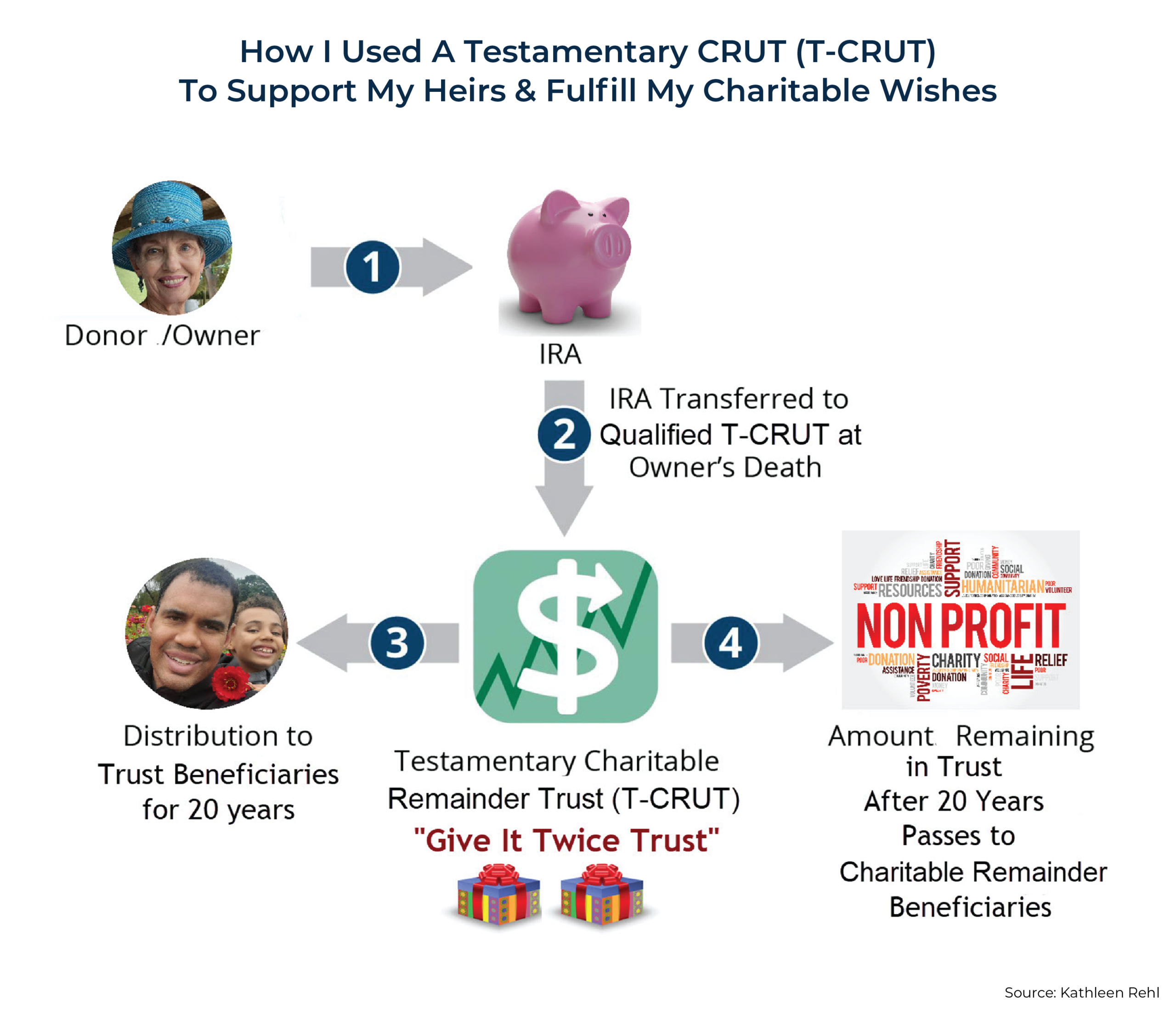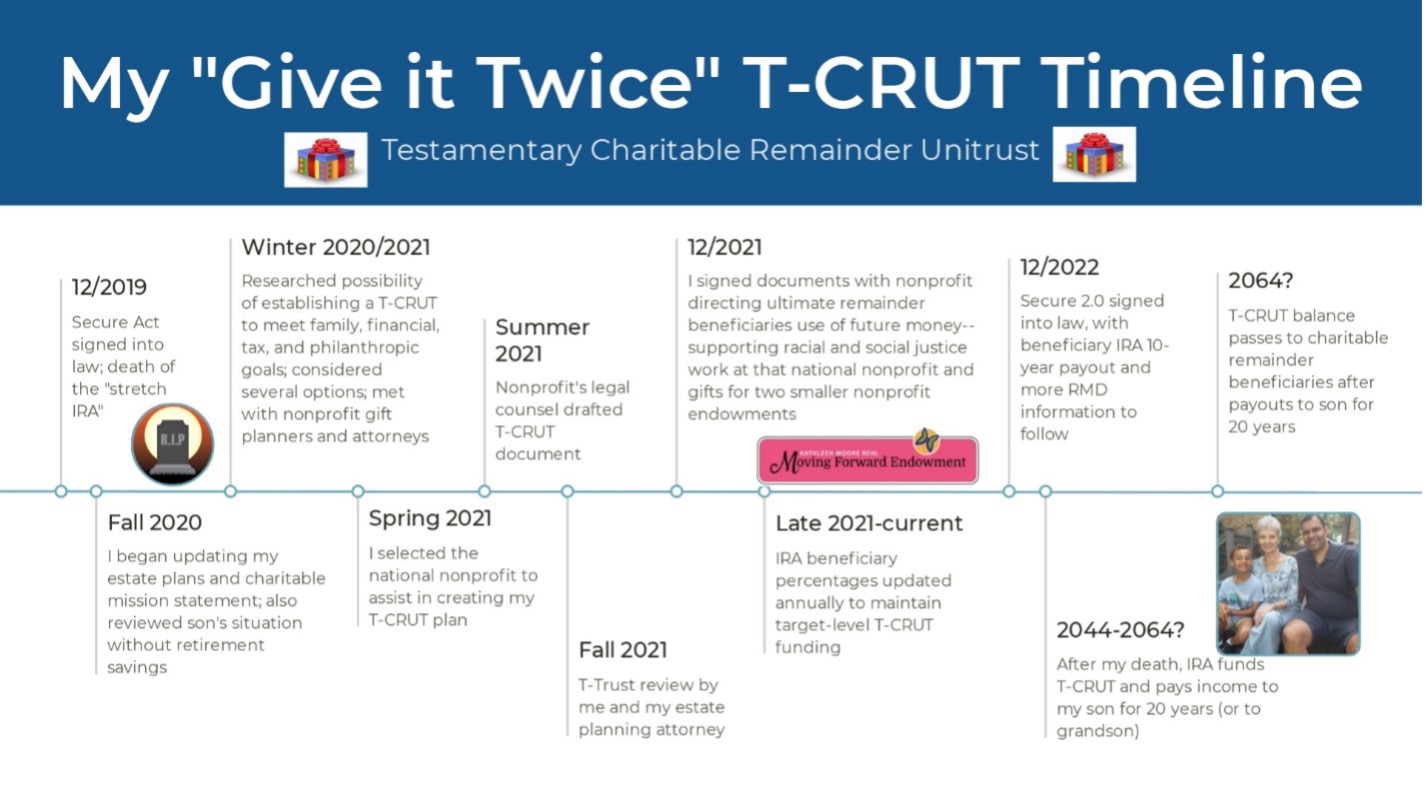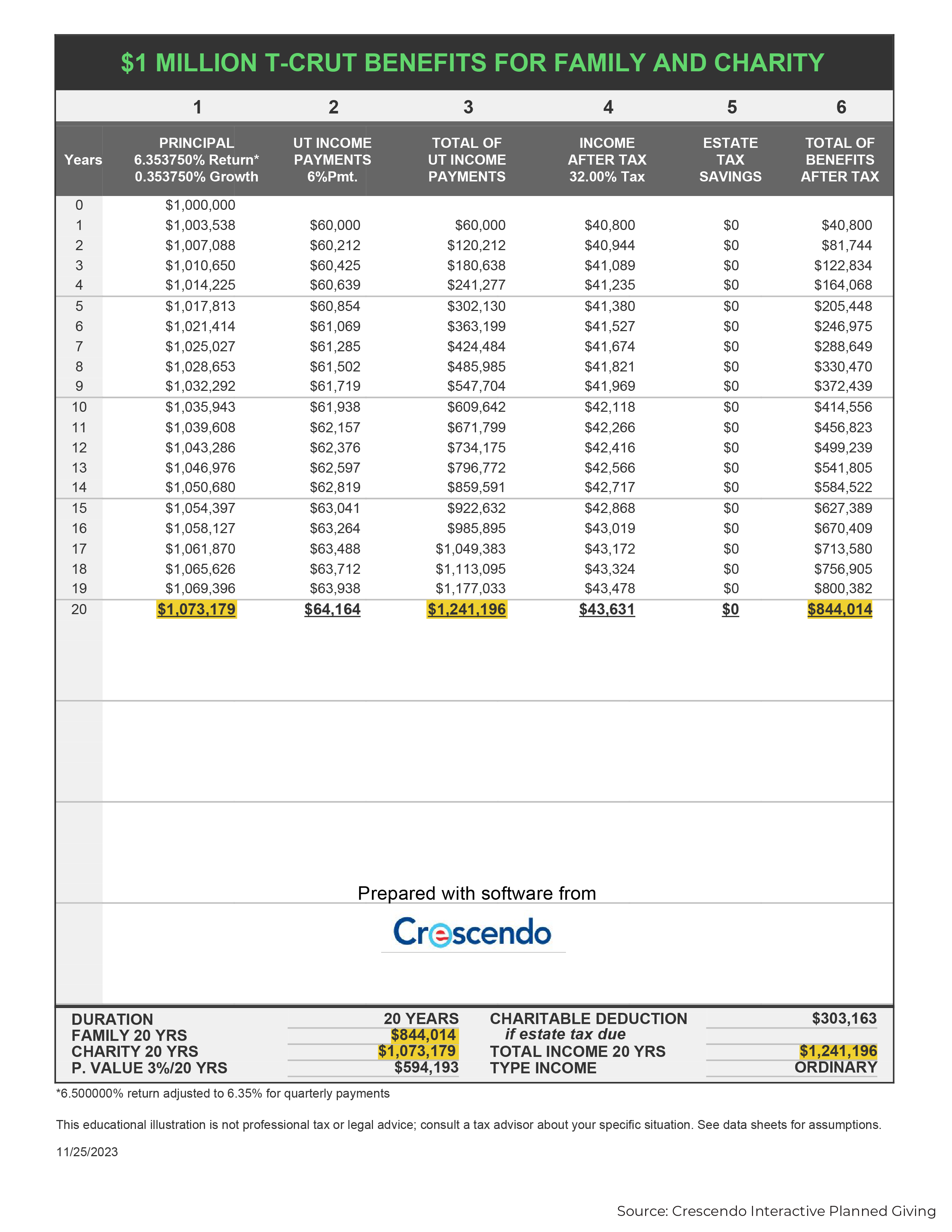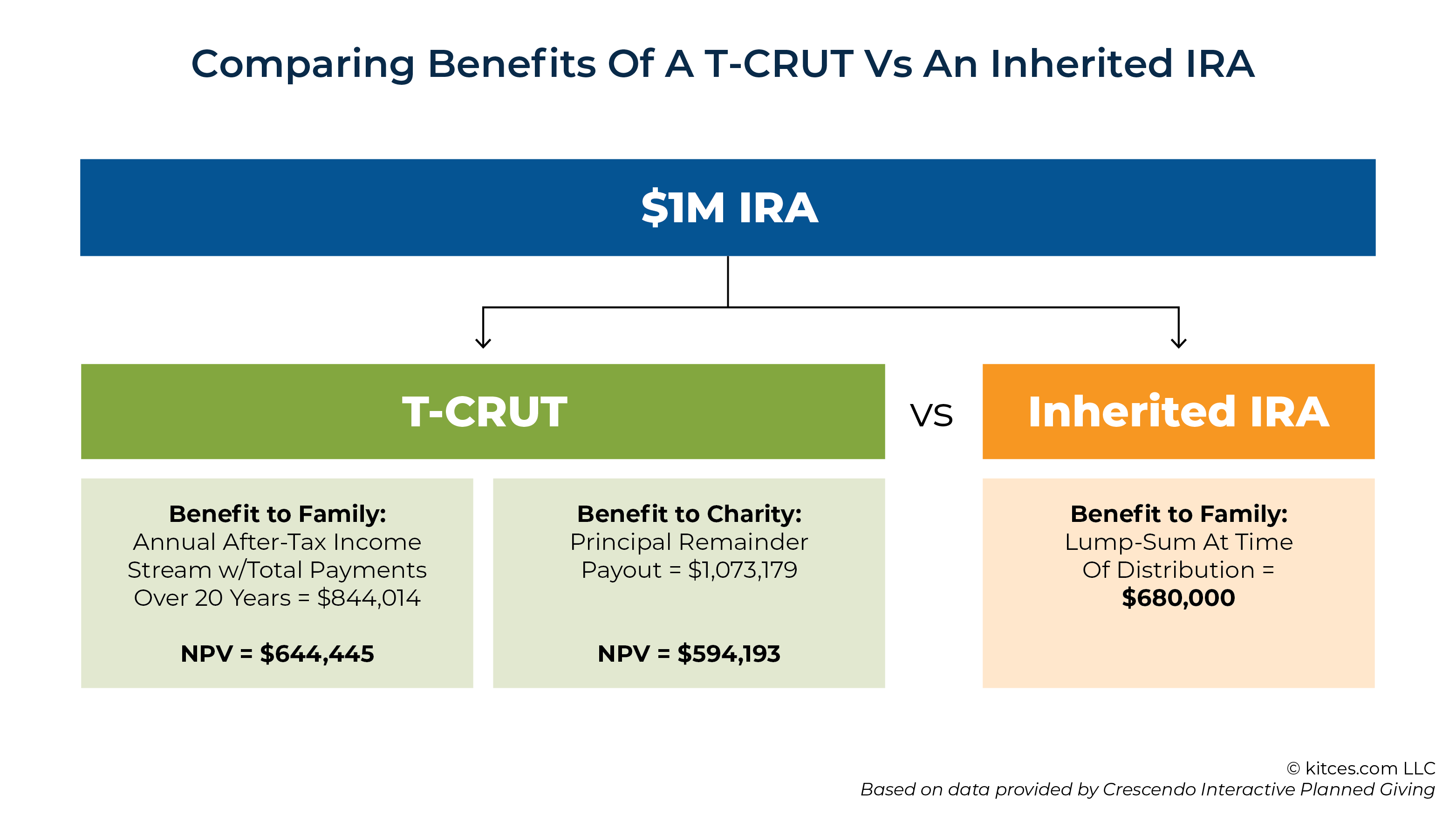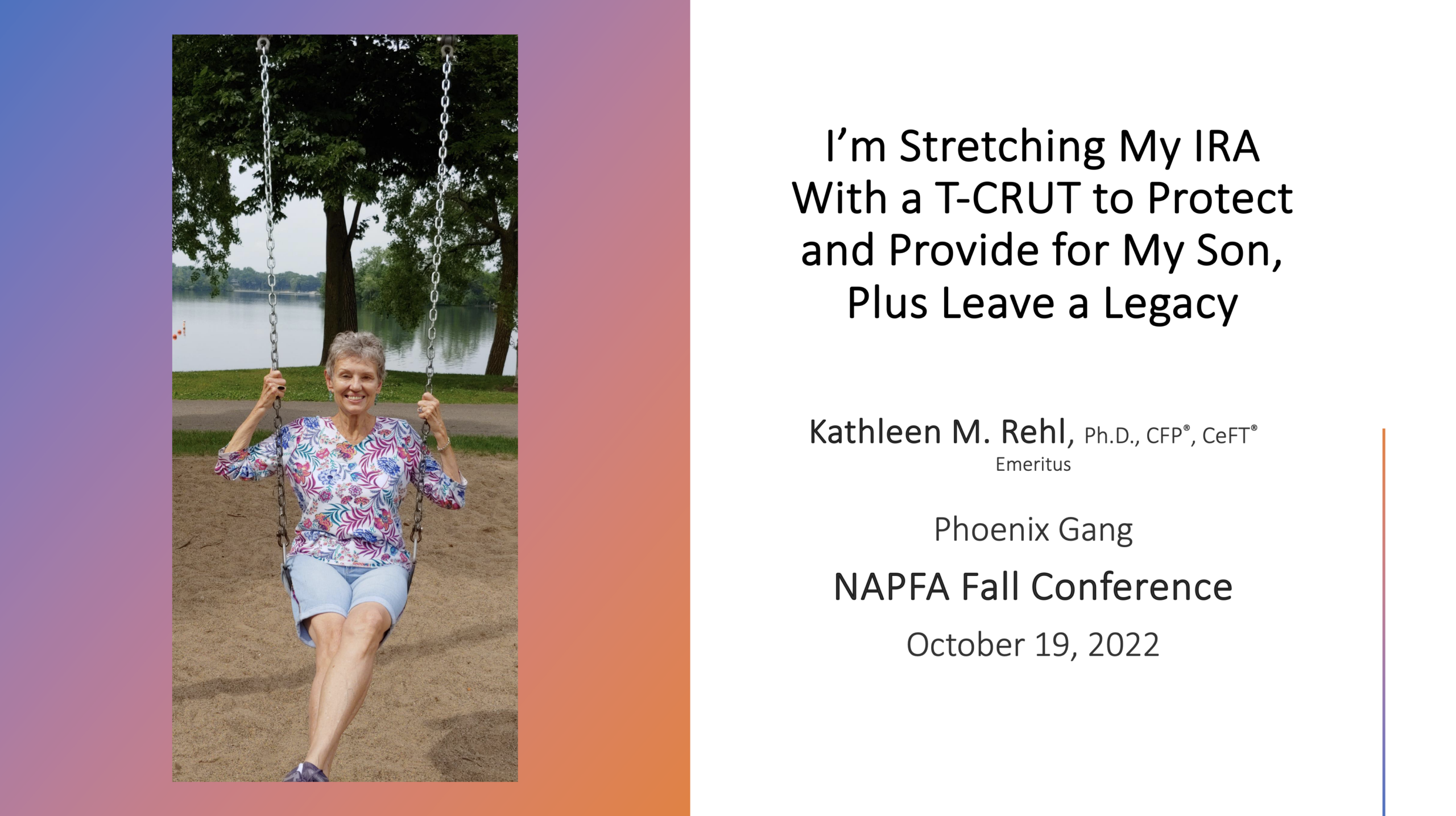Executive Summary
In late 2019, Congress passed the Setting Every Community Up for Retirement Enhancement (SECURE) Act, introducing several significant changes to retirement planning. Of the many provisions in the bill, the so-called "Death of the Stretch" arguably received the lion's share of consternation from the financial advisor community. Under the new law, non-spouse beneficiaries (with few exceptions) must now withdraw the entirety of an inherited IRA within 10 years of the account owner's passing rather than over their own lifetimes. This shift has led financial advisors to explore new strategies for mitigating the resulting tax-planning challenges. One effective approach is the use of a Testamentary Charitable Remainder UniTrust (T-CRUT). As a non-person entity, the T-CRUT is not subject to the 10-Year Rule and can be designated as the IRA beneficiary while naming the original non-spouse beneficiary as an income recipient of the trust and a charitable organization as the remainder beneficiary. This allows the account to grow on a tax-deferred basis, with income to beneficiaries being taxed when distributions are made.
In this guest post, Kathleen Rehl, a "reFired" financial planner and author of "Moving Forward on Your Own: A Financial Guidebook for Widows", shares her story of how (and why) she used a T-CRUT to create, upon her passing, a steady stream of income for her son, thus preserving the wealth of his legacy over time, avoiding the income tax burden that he would potentially encounter as the sole beneficiary of her IRA, and leaving a portion of that account to various nonprofits she supports.
Notably, her strategy to preserve her son's wealth while meeting her own charitable goals relies on 4 key principles. First is that the underlying vehicle is a Charitable Remainder UniTrust (CRUT), which pays a fixed percentage of the trust's value for either a specified number of years (not to exceed 20) or through the lifetime of the beneficiary. Second is that the CRUT is testamentary (i.e., it is an 'empty basket' that doesn't receive funds until the owner's passing). Third, the IRA assets are directed to the T-CRUT as its funding source upon her passing, and fourth, that, at the end of the specified period, a minimum of 10% of the initial fair market value of the assets placed within the trust is transferred to a qualified charity (or charities) as the final remainder beneficiary.
While such a strategy may not provide the same level of after-tax benefit to her son if he were to inherit her IRA outright (where he would be faced with the temptation to empty the account and spend the proceeds immediately), the T-CRUT strategy ensures her son's financial security through an annual income stream lasting into his retirement as well as leaving a charitable legacy that matches her values. As such, while leaving funds in an IRA may be the better option for those seeking to maximize wealth, using a T-CRUT to preserve wealth for a beneficiary while meeting philanthropic goals can be a very appealing solution.
Ultimately, the key point is that there are a number of tools that financial advisors can use to help their clients' beneficiaries circumvent the tax burden (as well as other potential challenges) associated with inheriting retirement accounts. More importantly, using various tax-efficient "Give It Twice" charitable tools allows financial advisors to help their clients create comprehensive estate plans that can benefit both their loved ones and the causes that are most meaningful to them!
As of 2020, it's farewell to the "Stretch IRA" and hello to the Testamentary Charitable Remainder UniTrust (T-CRUT). The Setting Every Community Up for Retirement Enhancement (SECURE) Act killed the stretch IRA. But although the stretch IRA may no longer be an option for many taxpayers, there are strategies to mitigate the impact of its absence. One such strategy, outlined by Jeffrey Levine in his prior blog article, includes implementing a CRUT:
…as a way to mitigate the impact of the 'death' of the 'Stretch', some practitioners have suggested naming would-be Non-Eligible Designated Beneficiaries as the income beneficiaries of a CRUT, and then naming that CRUT as the beneficiary of the individual's retirement account (instead of naming the Non-Eligible Designated Beneficiaries directly on the beneficiary form).
At the most basic level, a CRUT is a trust that receives assets, makes ongoing distributions of those assets (and their earnings) for some period of time (as described further below) to a named beneficiary, and then terminates and sends whatever is left in the trust (the remainder) to a qualifying charity.
CRUTs may not be the ideal strategy when it comes to maximizing wealth, because the requirement to leave a significant portion of the trust's assets to charity can reduce the overall amount available to heirs, especially considering the potentially long time frames typically needed to benefit from the extended tax deferral advantages.
However, CRUTs can be a very attractive strategy for individuals seeking to support loved ones by protecting wealth (while offering them a steady stream of annual income) and fulfilling charitable goals. Personally, I've planned to strategically use a Testamentary Charitable Remainder UniTrust (T-CRUT) funded with $1 million from my individual retirement account (IRA) to overcome this IRA change and an accompanying problem. Using this T-CRUT approach, I'm creating a 'pension' for my son via future gifts to the nonprofits I support now.
This tool can attract clients with charitable interests concerned about their family inheriting a large IRA with an accompanying tax burden, but it is not appropriate for retirement account owners who are solely interested in maximizing the transfer of wealth to heirs.
In my last Nerd's Eye View blog article, I discussed how my values align with charitable giving. I update my 1-page charitable mission statement about once a year, which helps guide my giving decisions.
I share this second personal story to inspire financial advisors to consider including Testamentary Charitable Remainder UniTrusts (T-CRUTs) in their toolkits to help retired clients with values-based, purposeful legacy planning.
It's said that we are happiest when our lives have meaning and have a positive impact. That includes expressing gratitude for the blessings I've received during my lifetime. One way I can actively demonstrate appreciation is through my giving.
Especially during our current (unprecedented) time of intergenerational wealth transfer and the longevity economy, there are implications for philanthropy and other Boomers like me.
For example, it's not my goal to leave everything I've worked a lifetime for to my family. Instead, I've arranged for them to inherit some while providing for charities I cherish. Many of my friends mirror this view.

Nerd Note:
For additional perspectives about Kathleen's work, Michael interviewed her on the Financial Advisor Success Podcast Episode 106: Empowering Widows Financially By Helping Them Navigate the 3 Stages of Widowhood. Her work was also featured in the August 23, 2023, guest column, "Legacy IRA" Rollover To A Charitable Gift Annuity: Using This New Tax-Advantaged Opportunity To Help Clients Achieve Charitable And Retirement Goals.
"I'll Never Be Able To Retire" Vs The Traditional IRA Conundrum
Right before what we were hoping to be a happy holiday weekend last fall, my son called me. "I was let go from my job yesterday, Mom. Things just didn't work out with the new boss and me. They're doing some corporate restructuring. So, I'm out." Our conversation continued, with me being a supportive listener as my heart broke for my son's situation.
Unfortunately, I've received other calls like this over the years. Now in his mid-40s with 2 graduate degrees, my son has held numerous professional positions, ranging from several months to almost 10 years. He's earned 6-figure incomes as a full-time employee and less as a contract worker. Health challenges plus a moderate disability sideline him periodically. The pandemic posed employment problems. As a result of his patchwork employment history, my son has no retirement savings. He cashed out his 401(k) and 403(b) plan accounts for living expenses after terminations. Earlier in his working years, my son had a traditional IRA; however, an unscrupulous relative talked him into withdrawing that money to invest in rental real estate, which subsequently went belly up. When he inherited his late father's retirement account several years ago, that quickly evaporated, too.
This recent phone call reinforced my decision 2 years ago to provide for and protect my son. In the past, I had designated my adult son as the outright beneficiary of my traditional IRA, thinking it was the best choice. However, as circumstances evolved, so did my perspective.
Over the years, I diligently funded multiple tax-deferred retirement accounts, including a traditional IRA and various employer-sponsored plans. My frugal lifestyle and consistent contributions led to a substantial retirement nest egg, which I consolidated into my traditional IRA upon semi-retirement at the age of 72. That's when I stopped saving more money there. With most of my living expenses covered by Social Security, a modest pension, and other investments, I only withdraw the minimum required annually by law. This conservative approach has led to a healthy traditional IRA balance, currently over $1.5 million.
However, I could see this seemingly robust financial situation being a dilemma for my son as the beneficiary. The IRA, continuing to grow tax-deferred, might become a taxable time bomb for him. Inheriting such a substantial IRA could be overwhelming, potentially leading to hasty financial decisions or reckless spending. It could be like winning the lottery for him, with others ready to help him spend the jackpot quickly.
The SECURE Act Shook Up IRA Distribution Rules For Inheritors, Starting In 2020
At the end of 2019, Congress and the President enacted the Setting Every Community Up for Retirement Enhancement (SECURE) Act, which increased the impact of the Required Minimum Distribution (RMD) rules for beneficiaries of retirement plans, eliminating the ability to stretch IRA withdrawals over a beneficiary's lifetime for almost everyone except a few eligible designated beneficiaries, including surviving spouses and children under 18. So, after I die, my son (a non-eligible designated beneficiary) would have to drain my IRA within 10 years and pay taxes on all money inherited from my IRA. That would be a huge tax hit!
Under prior law, beneficiaries of inherited retirement accounts could take distributions based on their life expectancy. Indeed, I'm doing that now with a small IRA I inherited from my mother 17 years ago, withdrawing only the RMD amount based on my life expectancy. With the SECURE Act, however, the shorter 10-year payout period for taking distributions accelerates income tax due, possibly bumping beneficiaries into a higher income tax bracket. Beneficiaries may be subject to RMD rules for inherited IRAs depending on whether the account owner died before or after age 73. Either way, the account must be depleted within 10 years.
The financial community was taken aback by the proposed guidance released by the IRS at the beginning of 2022. The modifications as prepared would affect non-qualified designated beneficiaries by mandating distributions in years 1 through 9 if the deceased was required to take RMDs at the time of death. That, plus emptying the entire account by the end of the 10th year after the account owner's death!
In October 2022, the IRS eliminated penalties for beneficiaries who failed to withdraw their RMDs under the new law until final regulations were issued. Those impacted by the new rules who 'failed' to take RMDs in 2021 and 2022 would not be penalized. Subsequently, the IRS extended the 2023 inherited IRA RMD penalty waiver in July 2023 for individuals whom the upcoming guidelines might impact. The IRS indicated they plan to publish the final advice in 2024.
For my son, the implications are clear: as the non-eligible beneficiary of my IRA, he would experience a substantial increase in taxable income over the 10-year period after my death. Before the passage of the SECURE Act, he might have had the flexibility to 'stretch' withdrawals over his lifetime, thereby mitigating the tax consequences. Or, if someone talked him into withdrawing everything quickly, he would lose even more to income tax.
A Thoughtful Solution To Provide For And Protect My Son – The T-CRUT
In late December 2020, I started reviewing my estate documents, as I do every year, to determine if changes were necessary. Then, in early January, a disruptive family event occurred. I wrote in my journal, "I'm very worried. If I die soon, my son will inherit $1.5 million from my IRA plus a significant amount in my trust. The way things stand today, he probably would be persuaded to withdraw everything immediately from the IRA and spend the trust money, too. Even if something remained in my IRA, he would need to drain that account in 10 years. I have to make changes to protect him."
Back to the drawing board I went, which included meeting with my local estate planning attorney and amending my living trust to create a second trust at my death to help manage non-IRA money my son would inherit. We discussed using a specific estate planning tool that would involve leaving part of my IRA to a Testamentary Charitable Remainder UniTrust (T-CRUT) after my death.
To provide some level of economic security for my son after I'm gone and protect him from potential predators, in 2021, I established plans for a T-CRUT to be funded with $1 million from my traditional IRA after I die. As a partial beneficiary of my IRA, my T-CRUT will incur no tax liabilities when it receives the IRA assets, thanks to the charitable trust's tax-exempt status.
I met with a local community foundation to talk about the possibility of them being named as the T-CRUT trustee and ultimate beneficiary. That organization could help with part of the task, but they were not able to do everything needed. Indeed, they agreed that I should approach the national nonprofit organization that would be the final beneficiary of my proposed T-CRUT, the Unitarian Universalist Association (UUA). Bingo! That was the answer.
Specialized legal counsel used by this national organization could prepare the customized trust document. Then, after my death, they would serve as trustee for the required 20-year period. Afterward, following my signed letter of intent directive, they would distribute 50% of the remainder principal to create the Kathleen Moore Rehl Moving Forward Endowment and to 2 Unitarian Universalist congregations' endowments.
I've designed my T-CRUT to give my son taxable payments of 6% of the trust's annual value determined yearly. Paid quarterly, his income stream will continue for 20 years. In the unfortunate event of his premature passing, those checks will continue to his son (my grandson) throughout the remainder of that 20-year term.
Below is a simplified flowchart showing how my T-CRUT works:
In the spring of 2021, we moved forward with this approach. It took several months to complete this process, including reviews by me and my estate planning attorney. I signed my new trust document in early December 2021. The letter of intent was signed by UUA officials and me shortly afterward. By the end of that month, I changed my IRA beneficiaries with a simple form from Vanguard. I adjusted the percentages so that $1 million was designated for the UUA. I'll continue to adjust this percentage each year to maintain this giving level.
The timeline of how my T-CRUT evolved is illustrated in the graphic below:
In essence, the strategy I used to fund a T-CRUT with IRA assets relied on 4 central principles, as follows:
- The Strategy's Underlying Tool Is A Charitable Remainder UniTrust (CRUT): This trust pays a fixed percentage of the trust's value (which must be at least 5% and no more than 50%) as revalued annually to one or more beneficiaries for either a specified number of years not to exceed 20 or the life of the beneficiary. This irrevocable trust was created under the authority of Internal Revenue Code §664 as part of the Tax Reform Act of 1969.
I chose 20 years as the distribution period rather than opting for life income for my son for several reasons, including that he may not live long after I pass. I'm projected to live well into my 90s; however, my son's outlook could be less favorable. Should he die prematurely, trust income will continue for his son (my grandson) throughout the full 20 years.
- The T-CRUT Is Testamentary By Nature: A T-CRUT is established in a person's will or living trust, or it can be set up as a standalone trust document created during their lifetime. This unfunded trust basket waits to be funded with assets after the owner's passing. The trust document outlines the terms of the T-CRUT, including the trustee's responsibilities, the income beneficiary, the income distribution schedule to the non-charitable beneficiary, and the ultimate remainder beneficiary – the charitable organization(s). In Section 4 of Revenue Proceeding 2005-57, the IRS provides a Sample Testamentary Charitable Remainder Unitrust – Term of Years declaration "created by an individual who is a citizen or resident of the United States and that provides for a term of years unitrust period."
I couldn't use this basic declaration for my own personal T-CRUT because of several special provisions that needed to be included.
- IRA Assets Are The T-CRUT's Funding Source: The IRA's assets are directed to the T-CRUT upon the individual's passing. Because the T-CRUT is qualified under the Internal Revenue Code, the IRA may be transferred with the trust paying no income tax on the IRA. This action has tax advantages because leaving an IRA directly to a non-charitable beneficiary, like a family member, might result in higher income tax implications.
- A Charitable Organization Is Chosen As A Remainder Beneficiary: At the end of the specified period (i.e., up to 20 years or upon the beneficiary's death), the remaining assets in the trust go to a charitable organization(s) chosen by the individual who established the T-CRUT. The IRS mandates that for a trust to qualify as a CRUT, a minimum of 10% of the initial fair market value of the assets placed in the trust must eventually be payable to a qualified charity or charities as the ultimate remainder beneficiary.
My T-CRUT's remainder beneficiary is the Unitarian Universalist Association. Upon the UUA's receipt of the Trust's proceeds, the UUA will distribute this gift as specified in my statement of intent letter, signed by me and UUA officials, which accompanies my T-CRUT's document: 25% for each of 2 local UU congregations for their permanent endowment funds and 50% for the UUA to create the Kathleen M. Rehl Moving Forward Endowed Fund, which will support the UUA's racial justice work.
Pros And Cons Of Implementing A T-CRUT Strategy
Listed below are some of the main advantages of a T-CRUT that were most appealing to me. These benefits may also be attractive to others considering this strategy:
Advantages
- Stretches taxable payments to income beneficiaries for up to 20 years or for life
- No taxes on IRA when distributed to charity
- Potentially reduces tax for income beneficiaries because inheritors can spread income payments received over more than 10 years mandated for inherited IRAs by the new tax law; in some cases, they may also save income beneficiaries from moving into higher tax brackets
- Continues tax-deferred growth inside the trust
- Protects the IRA's value from creditors or others
- Income beneficiaries may end up with more money than if receiving an IRA outright, depending on their circumstances
- Flexibility to change the T-CRUT plan before the donor's death
- Can generate charitable estate-tax deduction
- Supports personal values
Disadvantages:
Here are what some may consider to be drawbacks of a T-CRUT; however, for me, the tradeoff was the great advantages that fit what I wanted to accomplish.
- More complex than an outright gift to an heir or friend
- Nonprofit remainder beneficiary may not be able to administer trust; an alternative would be needed
- Requires a specialized attorney to draft the document
- May require certain management costs
Who May Be A Good Fit For Using The T-CRUT?
My circumstances were ideal for a T-CRUT, as I fit all the characteristics of what could be described as about perfect. The 8th item in this list – to be charitably inclined – is paramount. Without this element, a T-CRUT plan will fail.
- Mature individual as donor
- Large IRA balance to fund the T-CRUT, typically $250,000 or more
- 'Special situation' heir
- Want to 'stretch' IRA distributions
- Goal is not to give all assets to the family
- Prefer reducing tax
- Leave a legacy matching the donor's values
- Charitably inclined—without this element, a T-CRUT is not viable
The Financial Benefit Calculations For My Personal T-CRUT Strategy
Crescendo Interactive Planned Giving Software provided the calculations in the trust benefits table below. The table illustrates the projected principal and income of my T-CRUT over a 20-year trust duration, along with an estimate for the remainder unitrust benefits for my son and charitable organizations. Notably, these results would vary with different assumptions, such as for the trust return and growth, income payment rate, term of years or life payments, income tax rate, and applicable Federal interest rate.
Column 1: Trust principal. If the trust has a net return of 6.358% and pays out 6% annually, as shown in Column 2, then there is 0.358% annual growth of the principal. Any growth on the principal is tax-free so long as there is no unrelated business income. The $1,000,000 initial principal becomes $1,000,000 × 1.00358 = $1,003,538 at the end of year 1, and $1,073,179 at maturity in year 20.
Columns 2 and 3: Income payments. The income amount is calculated by multiplying the trust balance by 6% on January 1 of each calendar year. As the principal increases (by 0.35% each year), so too does the income increase. While the trust income is $60,000 in year one, it gradually increases to $1,069,396 (the principal at the end of year 19) × 6% = $64,164 by year 20.
Column 3: Accumulated value of all income payments. By year 20, the cumulative total of $1,241,196 will have been paid to the family.
Column 4: After-tax income. After accounting for an assumed 32% tax rate, the $60,000 initial income payment in year 1 is reduced by a tax of 32% ×$60,000 = $19,200, so the total income after tax would be $60,000 – $19,200 = $40,800.
Column 5: Estate tax savings. Because my total net worth is below the level requiring payment of estate tax, the charitable deduction of $303,163 results in estate tax savings of $0.
Column 6: Total income after tax and the estate tax savings. The cumulative after-tax benefit equals $40,800 in the first year and comes to a total of $844,014 in year 20.
At the base of the table is a section that summarizes the total charitable deduction amount ($303,163) that would be available to use if an estate tax were due, the total benefit for the family ($1,241,196 pre-tax, and $844,014 after tax), the total duration of the plan (20 years), and the total benefit left to charity ($1,073,179). Assuming a 3% discount rate over 20 years, it also shows that the unitrust remainder value ($1,073,179) has a present value of $594,193.
As the table above shows, the total after-tax benefits to my son with the T-CRUT in place are projected to be $844,014, with a net present value of approximately $644,445 (again assuming a 3% discount rate) and $1,073,179 (NPV of $594,193) remaining for my charitable organizations. While my son may receive $680,000 after paying income tax without the T-CRUT, my concern is that he would spend it immediately and put his future financial security at risk. Furthermore, without the T-CRUT, my charitable organizations would get nothing.
The financial benefits are substantial, assuming my death in 2044, a net investment return of 6.5%, and a 6% payout rate in quarterly installments to my son. This approach provides a steady 20-year annual income stream while ensuring that my son has a level of financial security during his retirement years.
Moreover, with 20 years to grow, my son may ultimately inherit more money overall. This innovative approach effectively navigates the new mandate to empty an inherited IRA in 10 years by making a full distribution into the T-CRUT, which provides for a steady stream of income for my son over the subsequent 20 years.
My Legacy Will Continue
After I die and with the T-CRUT having paid income to my son for 20 years, half of the remaining funds in my T-CRUT will be directed to a national nonprofit organization to establish the Kathleen Moore Rehl Moving Forward Endowment, dedicated to promoting racial justice. This cause resonates deeply with me. Additionally, one-fourth of the remaining balance will be given to each of the permanent endowments of 2 other nonprofits to support their social and racial justice work.
This "Give it Twice" T-CRUT offers the best of both worlds: my son will enjoy 2 decades of reliable income, and the remaining funds will support causes that resonate with my values and personal experiences.
How Advisors Can Help Clients With Their Charitable Impact
- Your clients' philanthropic focus will be most satisfying if directed toward causes that resonate with their values and personal experiences.
- Incorporating philanthropy into your clients' estate plans allows them to make a meaningful impact while also benefitting heirs. By exploring various charitable giving strategies, you can tailor approaches to meet clients' financial objectives and their desire to support philanthropic organizations while saving taxes for beneficiary heirs.
- When appropriate, involving your client's family in charitable giving decisions can encourage shared values and a commitment to philanthropy. As their professional advisor, consider facilitating family meetings to discuss philanthropic intentions with loved ones and selecting nonprofits to support.
Several Ways For Advisors To Start T-CRUT Conversations
Before I retired from Rehl Financial Advisors, I incorporated charitable planning into each client's overall financial and estate planning. Indeed, I was recognized by Mutual Funds Magazine as one of the nation's "top 100 financial advisors", emphasizing my area of expertise as charitable planning plus assisting surviving spouses.
Today, I continue to assist nonprofit organizations in promoting their planned giving programs pro bono. As a member of The American College of Financial Services Adjunct Faculty, I'm part of their Chartered Advisor in Philanthropy Program. Yes, I'm deeply entrenched in charitable planning.
Below are a few ways I've encouraged folks' interest in various charitable gifts for their favorite nonprofit(s):
- Create print and online graphics to encourage readers to consider possibilities. Little eye-catching visuals don't need to tell the whole story – just get people interested to make inquiries and ask questions. Here's one sample I used in a nonprofit's online newsletter, which intrigued a couple who later contacted me. We're now talking about why they want to take action, how they can do this using an appropriate giving vehicle and the right professionals, and what the result will be. I've created many of these little "Inspired Giving" graphics that are used by nonprofits.
- Bring up this topic during a client meeting to open the door for future discussions. Consider the following sample dialogue starter:
Mrs. Jones, many of the folks we work with have included one or more of their favorite charitable organizations in their estate plans. I've done that myself, too. With recent tax law changes, it makes a lot of sense.
Using these new approaches, we can give to our families and make a gift to a nonprofit that supports our values. I know you've been involved with the local animal shelter as a volunteer and annual donor.
So, I wondered if you might like to know what some of our other clients have done and how you might use these ideas to benefit your family and the animals you love.
- Share stories of real-life people who have implemented plans for a T-CRUT. Post these on your blog, in print, or in online publications to be read by an interested audience. For example, I was asked to write about my own T-CRUT for AgeBuzz.com. Advisors might also share various ways to use a T-CRUT.
For example, here's an overview of how my clients set up what they called a "No Boy-Toy" Trust, which was a T-CRUT several years ago. Middle-aged singles-group members Alan and Ruth met, fell in love, and got married. It was Alan's first marriage, whereas Ruth had been married and divorced multiple times. They embodied the phrase "opposites attract". Ruth was 10 years older than Alan and a GED graduate working on an assembly line, whereas Alan was a computer genius with a post-Ph.D. Ruth had adult children from previous marriages, and Alan had none. They loved animals and were engaged in church. After their wedding, they relocated to a rural farmette Alan bought with his money. They called their new home "The Refuge". Many dogs, cats, ducks, and other creatures found a home there. Ruth retired soon afterward.
Before their marriage, Alan's prior will left his fortune to various nonprofits, nieces, and nephews. Ruth's outdated will left what little money she had to her children. Newly married, though, they wanted to alter their estate arrangements. Alan felt he would die before Ruth, probably due to the farm's risky equipment.
Thus, he was concerned that Ruth would inherit most of his estate when he died if he declared her the principal beneficiary, and that she might marry a younger 'gym partner' who would outlast her and acquire his fortune, he half-joked, with his preferred charitable organizations getting nothing. Alan wanted to provide for Ruth and leave a legacy for his favorite charities, giving nothing to any future 'boy toy'.
Their planning team included a financial planner, an attorney, and a national nonprofit foundation that agreed to manage a T-CRUT to be funded with IRA assets after Alan's future death – giving Ruth income over her lifetime, with the remainder going to multiple charities after her death. Alan also left certain nonretirement assets to nieces and nephews in his new estate plan. Other accounts went directly to Ruth.
By implementing this approach, Alan and Ruth found a harmonious balance between caring for each other's needs and leaving a meaningful philanthropic legacy. The involvement of professionals in charitable giving, alongside a partnership with an outstanding nonprofit, ensured the effectiveness and longevity of their philanthropic impact. (Note that tax savings weren't a driver of this T-CRUT.)
- Make a presentation about T-CRUTs. I've been invited to speak on this topic at national and regional events, including the Phoenix Gang conference (National Association of Personal Financial Advisors), the Alliance of Comprehensive Planners conference, California Lutheran University Next Gen Mentoring Forum, local chapters of the National Association of Charitable Gift Planners, and the National Association of Estate Planners & Councils. A Financial Planning Association chapter has also extended an invitation for me to speak in 2024.
Here's a downloadable PowerPoint show I created for one of these events.
Other Possible Tools For IRA Testamentary Direct Transfers
What can you do if a T-CRUT isn't the right fit for your client? For example, if they have a smaller IRA account of $100,000, where the numbers don't work for a trust, another approach may be appropriate. Or, a client who wants a fixed annual payment for the income beneficiary rather than a variable payment may consider an alternative planned gift.
A Testamentary Charitable Gift Annuity (T-CGA) involves donating assets to a charity in exchange for the charity's promise to pay a fixed amount to the donor's beneficiary. The charity may be named as an IRA beneficiary if it agrees to pay an annuity to the IRA owner's designated beneficiary. The IRA owner and the issuing charity would make a gift annuity agreement without taking effect until the remaining IRA assets are given to the charity after the owner's death. Since payout-based "gift annuity qualification" requirements vary over time and must be met when the gift annuity is funded, the agreement must state that the annuitant's payment will be determined when the IRA testamentary transfer occurs. The annuitant will receive all annuity payments as regular taxable income because the IRA assets transferred to support a charitable gift annuity have a zero-tax basis (the IRA owner never paid tax on these funds). A T-CGA may be an especially good option for smaller-sized IRA balances of less than $250,000.
A Testamentary Charitable Remainder Annuity Trust (T-CRAT) can provide the income beneficiary with a payment that is a fixed percentage of the trust assets at the time of creation, with the remainder given to charity. The charity's remaining amount must equal at least 10% of the trust's initial value, the same as the T-CRUT. A T-CRAT's irreversible nature makes it difficult or impossible to change the conditions of the trust. The payout to the non-charitable income beneficiary cannot increase if the CRAT's investments do very well in any given year, unlike a T-CRUT, because it is a fixed annuity.
Of course, nonprofits also encourage outright gifts from an IRA account. This can happen before death through a qualified charitable distribution (QCD). Each taxpayer aged 70.5 and older may direct up to $105,000 in distributions from an IRA to a qualified charity in 2024, up from $100,000 in 2023 (as the maximum annual QCD limitation of $100,000 will be inflation-adjusted for the first time in 2024, due to the passage of the SECURE Act 2.0 in December 2022). This gift is not taxed or included in one's taxable income. There is no limit on after-death contributions to a charitable nonprofit beneficiary.
Exploring the ever-evolving landscape of estate planning and philanthropy, including various charitable giving tools, will empower advisors to guide clients to make informed decisions that create a legacy beyond their lifetime.
A client's IRA can promote financial security for heirs and positively impact philanthropic causes through a well-planned T-CRUT. By navigating the complexities of estate planning and using tax-efficient charitable giving strategies, you can help your clients create a comprehensive plan that benefits their families and the causes they cherish.


